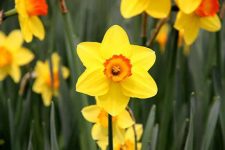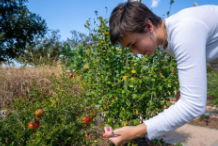UPCOMING EVENTS
K-State’s Turf and Ornamental Field Day is happening! It will be held at the Rocky Ford Turfgrass Research Center, 1700 Barnes Road, on Thursday, August 5. Due to the pandemic (which is receding for now!), we will have a change of structure for our tour of research plots and conversations with faculty and graduate students. Please note that the format and guidelines are subject to further change or cancellation, based on KSU and state/local health policies.
For a copy of the program and exhibitor information, go to http://www.kansasturfgrassfoundation.com/
You can register online at https://2021turfday.eventbrite.com
Online advanced registration is strongly recommended.
Parking at Faith E Free Church – 1921 Barnes Road, Manhattan, KS.
There will be no formal welcoming session this year. Tours will leave from the registration area about every 15 minutes beginning at 8:30 a.m. and running until 10 a.m. You can arrive anytime between about 8:15 am (or earlier) and 9:45 am to join one of the tours.
8 stops with different presenters, each running about 15 minutes.
No donuts or coffee will be provided, but a boxed lunch will be available when your plot tour finishes. Take your boxed lunch and find your own space to eat – there will be some chairs spaced out in shaded areas. Or, feel free to take it “to go.”
Vendors will be present from 8 a.m. until about 1 p.m.
REMINDERS
• Water plants as needed.
• Complete final pinching of chrysanthemums.
VEGETABLES
Fall Gardening
Probably the last thing most gardeners are thinking of now is planting vegetables. However, fall gardens will often produce higher quality, tastier cool-season crops as the vegetables mature during cooler, less stressful temperatures.
Plant slightly deeper than you would in the spring so the seed stays cooler and the soil around the seed stays moist longer. Plant more thickly and thin later. The plants may need to be protected from rabbits through the use of fencing.
Don’t worry about fertilizing before planting as there will be enough left over from the spring crops to provide for those grown in the fall.
Following is a “calendar” of what to do when.
Mid-July: Plant potatoes if you can find seed stock or have saved back seed potatoes. Do not use freshly dug potatoes as they have a built-in dormancy that will prevent growth. Also, grocery store potatoes are often treated so they don’t sprout.
Cabbage, broccoli, and cauliflower can be started from seed at this time. Choose a protected place where the soil can be kept moist and rabbits will not bother them. This will not be where they will grow the entire season but these crops will be transplanted about mid-August.
Late July: Seed beets, carrots and beans.
Late July to Early August: Seed spinach and long-season maturing lettuce. Leaf lettuce will be seeded later.
Second Week of August: Transplant cabbage, broccoli and cauliflower to their final location.
Mid to Late August: Seed radishes and leaf lettuce.
No need to fertilize before planting. Sidedress two weeks after transplanting or four weeks after sowing seed by applying 2 tablespoons of a 16-0-0 or 1 tablespoon of a 27-3-3, 30-3-4 fertilizer, or something similar per plant. You may also use a liquid fertilizer such as Schultz, Peters, Miracle-Gro or Rapid Gro according to label directions. It would be a good idea to wash off the leaves with clean water to prevent burn from the fertilizer.
Watering must occur more frequently because seed should not be allowed to dry out. Overhead watering often causes soil to crust, making it more difficult for young, tender plants to emerge. Prevent this by applying a light sprinkling of peat moss, vermiculite or compost directly over the row after seeding. Even better, use a soaker hose or drip irrigation right next to the row to allow water to slowly seep into the ground. (Ward Upham)
Weird Squash, Cucumbers or Melons
Occasionally we receive a call from someone who has a squash (or cucumber or melon) that just doesn’t look like what was supposedly planted. They often wish to know if that fruit had cross-pollinated with another vegetable close by. In such cases, the gardener is assuming that cross-pollination will affect the fruit. Such is not the case. The characteristics of the fruit are determined by the mother plant and is not affected by cross-pollination. However, there will be a problem if seed is saved for the next year from a flower that was cross-pollinated. All bets are off on what you will get if that happens.
So how do we end up with this weird fruit? Though it could be that the gardener had forgotten exactly what was planted, more likely is that the seed that was planted had been cross-pollinated before packaging. Another possibility is that it came from seed that came from fruit that had rotted in the garden the previous year. Regardless, don’t worry about planting different cultivars of squash or cucumbers or melons close to one another unless you will save seed from those plants. Though cross-pollination may occur in some cases, the fruit will not be affected. (Ward Upham)
Blister Beetles
These beetles are notorious for quickly stripping vegetables (especially tomatoes) and ornamentals of their foliage. There are several species of blister beetles which vary in size (often between 0.5-0.75 inch long) and color (such as black, gray or brown-striped), but most are recognized by their elongated, narrow, cylindrical, soft bodies with middle body part (thorax) narrower than the head or wingcovers.
Some home gardeners like to use hand picking as a nonchemical method for controlling these large insects. However, wear gloves and use caution because these beetles contain a substance called cantharidin. This chemical is an irritant capable of blistering internal and external body tissues exposed to the chemical. On tender human skin, body fluids of adult blister beetles may cause large, erect, watery blisters.
Chemical control of blister beetles is also possible and may be the only practical method of control if populations are large. Cyfluthrin (BioAdvanced Vegetable and Garden Insect Spray) and permethrin (Bonide Eight and Hi-Yield Lawn, Garden and Farm Insect Control) are recommended. Cyfluthrin and permethrin have a 0 day waiting period on tomatoes. (Ward Upham)
FRUIT
Remove Suckers and Watersprouts on Fruit Trees
Summer pruning should be done if your fruit trees develop suckers or watersprouts. Trees that were heavily pruned in the spring will likely produce numerous suckers and watersprouts during the summer. However some trees are just more likely to produce both types of growth even if not heavily pruned.
Suckers are growth that arises from the base of the tree or from roots. Watersprouts are the growth that appears on major branches and grows straight up. The included photo was taken during the dormant season to more easily identify the watersprouts. This may have to be done several times during the summer. It is important that these are removed during the growing season as removing them next spring will just encourage more watersprouts and suckers to appear. (Ward Upham)
PESTS
Budworms on Garden Plants
If you have noticed a small hole in the buds of some of your flowers, you may have tobacco (geranium) budworm (Helicoverpa virescens). Though a number of flowers can serve as hosts, geraniums and petunias are most commonly attacked. The larva of this insect damages the buds by boring into them before they open. The caterpillars feed on the flowers for about a month and then drop to the soil to pupate. There are normally two generations per year, with the second causing the most harm. The striped caterpillars vary widely in color with green, red, light brown and dark forms possible. The color of the larva is related to the color of the flowers on which they feed. The adult of this insect is a moth.
Damaged buds often fail to open. Those that do will show evidence of feeding on the petals. Damage normally peaks in late summer because of increased numbers from the second generation.
Control of the budworm is difficult. Handpicking at dusk can be effective on small plantings. For larger plantings, chemical control may be the only practical option. Look for products with synthetic pyrethroid active ingredients such as permethrin (Bonide Eight and Hi-Yield Lawn, Garden and Farm Insect Control), esfenvalerate (Asana, Bug Buster II), cyfluthrin (BioAdvanced Vegetable & Garden Insect Spray), bifenthrin (Hi-Yield Bug Blaster Bifenthrin) or gamma-cyhalothrin (Spectracide Triazicide). Products with the organic active ingredient spinosad (Natural Guard Spinosad, Captain Jack’s Dead Bug Brew, Monterey Garden Insect Spray) should also be effective.
Severe winters can be a natural form of control from one year to the next. Temperatures below 20 degrees F are hard enough to kill overwintering pupa. Because pupal cases are usually 2 to 6 inches deep, most exposed areas in Kansas will provide good control during a cold winter.
Microclimates next to heated buildings may allow survival. (Ward Upham)
Contributors: Ward Upham, Extension Associate
Contributors: Ward Upham, Extension Associate
Division of Horticulture
1712 Claflin, 2021 Throckmorton
Manhattan, KS 66506
(785) 532-6173
For questions or further information, contact: wupham@ksu.edu OR cdipman@ksu.edu
This newsletter is also available on the World Wide Web at: http://hnr.k-state.edu/extension/info-center/newsletters/index.html
The web version includes color images that illustrate subjects discussed. To subscribe to this newsletter electronically, send an e-mail message to cdipman@ksu.edu or wupham@ksu.edu listing your e-mail address in the message.
Brand names appearing in this newsletter are for product identification purposes only. No endorsement is intended, nor is criticism implied of similar products not mentioned.
K-State Research and Extension is committed to making its services, activities and programs accessible to all participants. If you have special requirements due to a physical, vision or hearing disability, or a dietary restriction please contact Extension Horticulture at (785) 532-6173.
Kansas State University Agricultural Experiment Station and Cooperative Extension Service K-State Research and Extension is an equal opportunity employer. Issued in furtherance of Cooperative Extension Work, Acts of May 8 and June 30, 1914, as amended. Kansas State University, County Extension Councils, and United States Department of Agriculture
Cooperating, Ernie Minton, Dean.
Blog Post: http://www.ksuhortnewsletter.org
Video of the Week: Efficient Water Use in the Garden
https://kansashealthyyards.org/all-videos/video/efficient-water-use-in-the-garden





